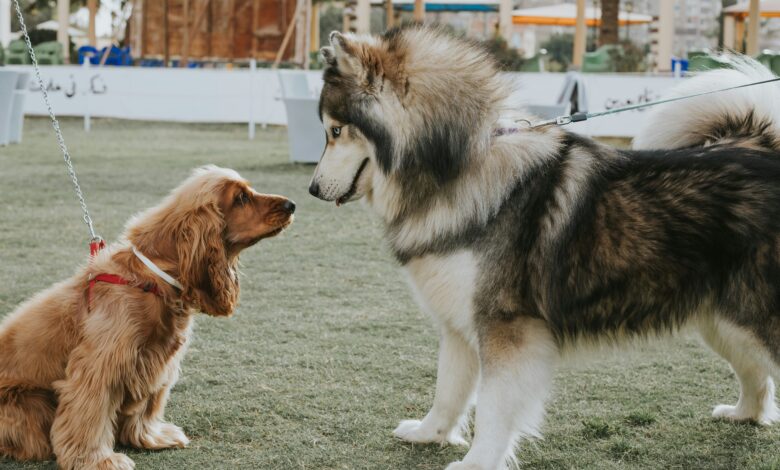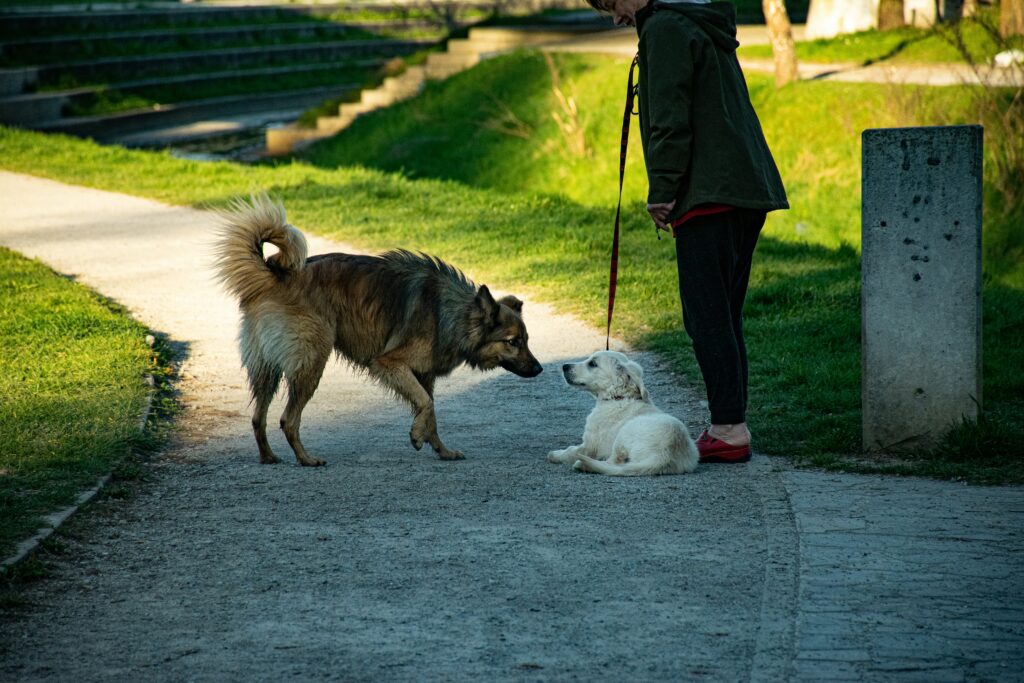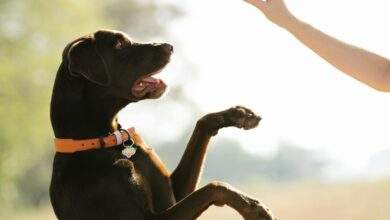
Table of contents
- The Joys and Challenges of Mixing Big Dogs with Little Dogs
- Mistake #1: Rushing the Introduction Process Between Big Dogs and Little Dogs
- Mistake #2: Ignoring Breed-Specific Traits When Pairing Big Dogs with Little Dogs
- Mistake #3: Failing to Provide Separate Safe Spaces for Big Dogs and Little Dogs
- Mistake #4: Leaving Big Dogs with Little Dogs Unsupervised Too Soon
- Mistake #5: Allowing Inappropriate Play Between Big Dogs and Little Dogs
- Mistake #6: Neglecting Training That Addresses the Size Difference Between Big Dogs and Little Dogs
- Mistake #7: Using Punishment-Based Methods When Introducing Big Dogs with Little Dogs
- Mistake #8: Overlooking Size-Appropriate Equipment for Big Dogs and Little Dogs
- Mistake #9: Failing to Recognize and Address Size-Related Anxiety in Either Dog
- Mistake #10: Not Preparing for Emergency Situations Involving Big Dogs and Little Dogs
- Building Harmony Between Big Dogs and Little Dogs
The Joys and Challenges of Mixing Big Dogs with Little Dogs
Having both big dogs and little dogs in the same household can bring immense joy and create a wonderful, diverse canine family. However, introducing big dogs with little dogs requires careful consideration and proper management to ensure everyone’s safety and happiness. As a pet parent to multiple dogs of different sizes, I understand firsthand the unique challenges and rewards that come with this special dynamic.
In fact, according to a 2023 survey by the American Veterinary Medical Association, approximately 38% of multi-dog households in the United States include both large and small breeds living together. Yet many pet parents make common mistakes when introducing and managing big dogs with little dogs that can lead to stress, conflict, or even injury.
Throughout this comprehensive guide, we’ll explore the 10 most critical mistakes to avoid when introducing big dogs with little dogs, along with practical, actionable strategies to create a harmonious multi-dog household. Whether you’re considering adding a new furry family member or looking to improve relationships between your existing big and little dogs, these insights will help you navigate this rewarding journey.
Disclaimer: This article is intended for educational purposes only and should not replace professional veterinary or behavioral advice. Every dog is unique, and situations involving big dogs with little dogs may require personalized guidance from qualified professionals.
Mistake #1: Rushing the Introduction Process Between Big Dogs and Little Dogs
One of the most common and potentially dangerous mistakes pet parents make is rushing the introduction between big dogs and little dogs. The excitement of bringing home a new furry family member can sometimes cloud our judgment, leading us to skip crucial steps in the introduction process.
Why Proper Introductions Matter for Big Dogs with Little Dogs
The size difference between big dogs and little dogs creates unique safety concerns. According to a 2024 study published in the Journal of Veterinary Behavior, dogs that are properly introduced over a period of at least 2-3 weeks show 65% fewer incidents of aggression or fear-based behaviors than those introduced abruptly.
The Right Approach to Introducing Big Dogs with Little Dogs
Start with Scent Exchanges
Begin by allowing your big dogs and little dogs to become familiar with each other’s scents before face-to-face meetings. Exchange bedding or toys between them, or use a clean cloth to gently rub on one dog and then let the other sniff it.
Use Barriers During Initial Visual Contact
Once your dogs are comfortable with each other’s scents, allow them to see each other through a baby gate or exercise pen. This gives your big dogs and little dogs the opportunity to observe each other in a safe, controlled way.
Progress to Controlled Meetings in Neutral Territory
When both dogs seem comfortable with visual contact, arrange brief meetings in neutral territory – somewhere neither dog considers their “territory.” Have one person handle each dog on a leash, keeping the interactions positive and brief.
Remember, successful introductions between big dogs and little dogs often take weeks, not days. Be patient and don’t rush the process, as laying this foundation properly will set the stage for a lifetime of positive interactions.
Regarding the financial aspects of pet ownership: Bringing a new dog into your home, especially when you already have a smaller one, comes with its own set of considerations. Just like ensuring you’re prepared for unexpected health costs, as outlined in ‘The Ultimate Guide to Pet Insurance: Top 9 Providers in the US,’ careful planning for introductions is key.
Mistake #2: Ignoring Breed-Specific Traits When Pairing Big Dogs with Little Dogs
Not all big dogs and little dogs are created equal when it comes to temperament, energy levels, and play styles. Ignoring breed-specific traits can lead to mismatched expectations and potential conflicts between your canine companions.
Understanding Breed Characteristics
According to research from the American Kennel Club, certain large breeds like Newfoundlands, Bernese Mountain Dogs, and Great Danes often have gentle, calm temperaments that can make them excellent companions for little dogs. Conversely, some small breeds like Jack Russell Terriers have high energy levels that might match well with active larger breeds.
How to Match Big Dogs with Little Dogs Successfully
When introducing big dogs with little dogs, consider these factors:
- Energy levels: A high-energy small dog might become frustrated with a laid-back large dog, while a calm small breed might be overwhelmed by an energetic big dog.
- Play styles: Some breeds prefer chasing games, while others enjoy wrestling or tug-of-war. Mismatched play styles between big dogs and little dogs can lead to frustration or accidental injury.
- Previous experiences: Dogs with positive past experiences with differently-sized dogs typically adjust more easily to living with big dogs and little dogs together.
The Association of Professional Dog Trainers recommends consulting with a professional trainer who specializes in multi-dog households to assess compatibility when introducing specific breeds of big dogs with little dogs.
When discussing multi-pet households: “Creating a peaceful multi-pet household is a rewarding experience. While our focus here is on dogs, the principles of careful introduction resonate across species, as you’ll discover in ‘Happy Together: A Guide to Successful Cat and Dog Integration.‘
Mistake #3: Failing to Provide Separate Safe Spaces for Big Dogs and Little Dogs
Every dog, regardless of size, needs a personal safe space where they can retreat when feeling overwhelmed or simply desire alone time. This becomes especially important in households with big dogs and little dogs living together.
The Importance of Personal Space
A 2023 study by the Center for Canine Behavior Studies found that multi-dog households that provided separate resting areas for each dog reported 47% fewer stress-related behaviors than homes where dogs were forced to share all spaces.
Creating Safe Zones for Big Dogs with Little Dogs
Here’s how to create appropriate safe spaces:
For Little Dogs:
- Provide elevated resting areas that big dogs cannot access
- Create small “caves” or covered beds where they can feel secure
- Use baby gates with small dog doors that allow small breeds to pass while keeping big dogs out
For Big Dogs:
- Designate comfortable areas where they can stretch out fully
- Create boundaries that little dogs understand to respect
- Provide appropriate chew toys that cannot be mistaken for small dog toys
Many pet parents of big dogs and little dogs find success with the “zone method,” which involves creating distinct areas of the home where each dog can retreat when needed. This approach respects the needs of both big dogs and little dogs without creating tension or resource guarding.
Highlighting the importance of patience and understanding: Introducing different species of pets requires a delicate approach and an understanding of their unique behaviors. The same patience and observation needed when introducing a new rabbit, as detailed in ‘How to Introduce a New Rabbit to Your Existing Pets,’ are crucial when dealing with dogs of different sizes.

Mistake #4: Leaving Big Dogs with Little Dogs Unsupervised Too Soon
Even when big dogs and little dogs seem to get along wonderfully, leaving them alone together too quickly can be a recipe for disaster. The physical size difference means that even friendly play between big dogs and little dogs can unintentionally lead to injury.
The Supervision Timeline
Research conducted by Purdue University’s College of Veterinary Medicine suggests that big dogs and little dogs should have supervised interactions for at least 3-6 months before being left alone together, depending on their individual temperaments and relationship development.
Safe Supervision Strategies for Big Dogs with Little Dogs
Gradual Alone Time
Start with brief periods (5-10 minutes) where you step out of the room but can still hear and quickly return to check on your big dogs and little dogs. Gradually increase this time as they demonstrate consistent appropriate behavior.
Use Management Tools
Consider using a lightweight drag leash on your big dog during supervised interactions with little dogs. This gives you quick control if play becomes too rough or if predatory chase behaviors emerge.
Create Safe Separation When Necessary
When you cannot supervise, use crates, exercise pens, baby gates, or separate rooms to keep big dogs and little dogs safely apart until their relationship is rock solid.
Remember that even the most well-behaved big dogs and little dogs should never be left completely unsupervised during the early months of their relationship. Taking the time to ensure safety now will provide peace of mind later.
When addressing the decision-making process before getting a new pet: Before even reaching the introduction stage, considering the inherent differences between breeds and temperaments is vital. If you’re still in the ‘which pet?’ phase, our article ‘Cats vs Dogs: Which Pet is the Perfect Match for You?‘ offers valuable insights.
Mistake #5: Allowing Inappropriate Play Between Big Dogs and Little Dogs
Play is a vital part of canine relationships, but not all play styles are appropriate between big dogs and little dogs. What might be normal rough-housing between two large dogs could potentially harm a small breed.
Recognizing Healthy vs. Risky Play
According to The American Society for the Prevention of Cruelty to Animals (ASPCA), healthy play between big dogs and little dogs should include frequent pauses, role reversals (where each dog takes turns being the chaser and the chased), and relaxed body language. Warning signs of inappropriate play include:
- One dog consistently pinning or body-slamming the other
- The big dog “mouthing” or putting their mouth around the little dog
- The little dog spending most of the time trying to escape
- Either dog seeming tense, fearful, or overly aroused
Redirecting Play Between Big Dogs and Little Dogs
Teach Appropriate Games
Encourage games that minimize physical contact between big dogs and little dogs, such as parallel play where both dogs chase their own toys side by side rather than wrestling with each other.
Use Positive Interruptions
When play between big dogs and little dogs becomes too intense, interrupt with a cheerful voice and redirect to a calmer activity, rather than scolding which can create negative associations.
Schedule Separate Play Sessions
Ensure both your big dogs and little dogs get adequate exercise and play appropriate to their size and energy levels. This often means providing separate play sessions with you that cater to each dog’s specific needs.
By managing play interactions between big dogs and little dogs thoughtfully, you can prevent both physical injuries and the development of fear-based behaviors in your smaller pets.
While emphasizing preparation and a calm environment: Setting the stage for a successful introduction is paramount. Just like the essential steps we recommend for a smooth welcome for any new dog or cat in ‘New Pet, No Worries! 10 Essential Steps for a Smooth Dog or Cat Welcome,’ a calm and prepared environment minimizes stress for everyone involved.
Mistake #6: Neglecting Training That Addresses the Size Difference Between Big Dogs and Little Dogs
Living successfully with both big dogs and little dogs requires specific training that acknowledges and addresses the size difference. Many pet parents focus on basic obedience but overlook the specialized training needed for multi-size households.
Essential Commands for Households with Big Dogs and Little Dogs
According to certified trainers at the Pet Professional Guild, these commands are particularly important when managing big dogs with little dogs:
For Big Dogs:
- “Gentle” – teaching big dogs to interact carefully with smaller animals
- “Leave it” – vital for preventing big dogs from picking up little dogs’ toys
- “Place” or “Go to bed” – directing big dogs to their designated area when necessary
For Little Dogs:
- “Come” with high reliability – essential for calling little dogs away from potentially dangerous situations
- “Wait” – preventing little dogs from rushing into big dogs’ spaces
- “Up” and “Off” – helping little dogs navigate to safe spaces when needed
Impulse Control Training
A 2024 study published in the Journal of Applied Animal Behavior Science found that big dogs living successfully with little dogs scored 40% higher on impulse control tests than those struggling in mixed-size households.
Focus on exercises that teach both big dogs and little dogs to:
- Wait calmly for food, toys, and attention
- Greet each other calmly without jumping or barging
- Accept handling and gentle restraint when necessary
Remember that consistent training benefits both big dogs and little dogs, creating clear boundaries and expectations that help everyone feel secure in the relationship.
Mistake #7: Using Punishment-Based Methods When Introducing Big Dogs with Little Dogs
Using punishment or dominance-based training methods can be particularly harmful when introducing and managing big dogs with little dogs. These approaches often increase stress and anxiety, potentially triggering fear-based aggression in either size of dog.
The Science on Training Approaches
Research from the University of Pennsylvania School of Veterinary Medicine demonstrates that dogs trained using punishment-based methods show increased aggression toward other dogs and humans compared to those trained with positive reinforcement. This risk is amplified in households with big dogs and little dogs, where even a momentary aggressive response could result in serious injury.
Positive Approaches for Managing Big Dogs with Little Dogs
Reward-Based Training
Use high-value treats, praise, and play to reinforce desired behaviors between your big dogs and little dogs. For example, reward your big dog for gentle interactions and your little dog for confident, appropriate behavior around larger canines.
Management Instead of Punishment
When mistakes happen between big dogs and little dogs (and they will), focus on preventing future incidents through better management rather than punishing either dog. This might mean adjusting your environment, supervision level, or training plan.
Build Positive Associations
Create situations where good things happen when big dogs and little dogs are together. This might include parallel walking, where both dogs walk in the same direction but with enough space to feel comfortable, or feeding special treats only when both dogs are calmly coexisting.
By focusing on positive interactions between big dogs and little dogs, you build a foundation of trust rather than fear, which is essential for long-term harmony.
Mistake #8: Overlooking Size-Appropriate Equipment for Big Dogs and Little Dogs
Using the same type of equipment for dogs of dramatically different sizes can create safety issues and management challenges. From collars and harnesses to toys and feeding stations, size-appropriate gear is essential when living with big dogs and little dogs.
Essential Equipment Considerations
According to The Whole Dog Journal, these are key areas where customized equipment makes a difference for big dogs with little dogs:
Walking Equipment
- Larger dogs benefit from front-clip harnesses or head halters that provide better control for the handler
- Small dogs typically need well-fitted harnesses rather than collars to prevent tracheal injury
- Consider dual-handle leashes for large dogs that provide both a standard grip and a traffic handle for close control around little dogs
Feeding Solutions
- Elevated feeding stations for big dogs prevent them from straining to reach floor-level bowls
- Feed little dogs in separate areas, potentially behind baby gates or on elevated surfaces to prevent resource guarding and food stealing
Play and Enrichment
- Provide size-appropriate toys clearly designated for big dogs versus little dogs
- Consider puzzle toys sized for each dog’s abilities and jaw strength
- Create exercise options suitable for each size, such as agility equipment scaled for big dogs and little dogs respectively
Investing in proper equipment for both your big dogs and little dogs not only improves safety but also ensures each pet can engage in natural behaviors appropriate to their size and needs.
Mistake #9: Failing to Recognize and Address Size-Related Anxiety in Either Dog
The size difference between big dogs and little dogs can create anxiety in either or both pets if not properly addressed. Many pet parents miss the subtle signs of stress that can eventually escalate into more serious behavioral issues.
Signs of Anxiety in Multi-Size Households
Research published by the Center for Canine Behavior Studies in 2024 identified these common stress signals in homes with big dogs and little dogs:
In Little Dogs:
- Excessive barking or “bossiness” toward big dogs (often misinterpreted as the small dog being “dominant”)
- Hiding, trembling, or avoiding common areas
- Resource guarding food, toys, or people from larger dogs
- Overreacting to normal movements from big dogs
In Big Dogs:
- Excessive self-restraint leading to stiffness around little dogs
- Frustration behaviors like chewing or digging when little dogs are present
- Avoiding play or movement when little dogs are nearby
- Excessive licking or displacement behaviors when approached by little dogs
Addressing Size-Related Anxiety Between Big Dogs and Little Dogs
Create Positive Associations
Work with a certified Applied Animal Behaviorist or Certified Dog Behavior Consultant to develop counterconditioning protocols that help both big dogs and little dogs feel positive about each other’s presence.
Provide Appropriate Outlets
Ensure both big dogs and little dogs have adequate mental and physical exercise appropriate to their size, breed, and energy level. A tired dog is generally less reactive and anxious.
Consider Calming Aids When Appropriate
For some dogs, veterinary-approved calming supplements, pheromone diffusers, or anxiety wraps may help reduce stress during the adjustment period when introducing big dogs with little dogs.
Recognizing and addressing anxiety early is crucial for successful integration of big dogs and little dogs, as chronic stress can damage their relationship and overall quality of life.

Mistake #10: Not Preparing for Emergency Situations Involving Big Dogs and Little Dogs
Even in the most well-managed households with big dogs and little dogs, emergencies can occur. Many pet parents fail to plan for worst-case scenarios, which can lead to devastating consequences if an incident does happen.
Creating an Emergency Plan
According to the American Animal Hospital Association, every home with big dogs and little dogs should have these emergency preparations in place:
Break-Up Plan
Have tools readily available to safely separate dogs in case of a fight, such as:
- A loud noise maker to interrupt (air horn or whistle)
- A barrier like a large piece of cardboard or baby gate
- A water spray bottle or garden hose
- Break sticks (only to be used by those trained in their proper use)
First Aid Kit
Maintain a pet first aid kit that includes supplies for both big dogs and little dogs, with wound care materials appropriate for different-sized animals. The Red Cross Pet First Aid App provides excellent guidance on emergency care.
Veterinary Planning
Have contact information readily available for:
- Your regular veterinarian
- The nearest 24-hour emergency veterinary hospital
- A veterinary specialist in canine behavior if tensions between big dogs and little dogs are increasing
Transport Solutions
Have appropriate carriers or restraints for safely transporting both big dogs and little dogs in an emergency, especially if one is injured and needs to be moved carefully.
By preparing for emergencies before they happen, you’ll be able to act quickly and effectively if your big dogs and little dogs ever experience a serious conflict or accident.
Building Harmony Between Big Dogs and Little Dogs
Successfully integrating big dogs with little dogs requires patience, knowledge, and consistent management. By avoiding these ten common mistakes, you’ll create a foundation for a peaceful multi-dog household where pets of all sizes can thrive together.
Remember that each dog is an individual, and the relationship between big dogs and little dogs will develop at its own pace. Celebrate small victories along the way, and don’t hesitate to seek professional guidance if you encounter challenges beyond your experience level.
With proper introduction, training, management, and love, big dogs and little dogs can form deep bonds that last a lifetime, bringing double the joy to your home and family.
Yes, but only after they have established a solid, trustworthy relationship over time. According to VCA Animal Hospitals, big dogs and little dogs should have consistently positive interactions under supervision for at least 3-6 months before being left alone together. Even then, providing separate spaces with baby gates or other barriers is recommended for times when you’ll be gone for extended periods.
Teaching gentle play between big dogs and little dogs requires consistent intervention and redirection. Interrupt play that becomes too rough with a positive interrupter like “Let’s go get a treat!” rather than scolding. Reward your big dog for gentle interactions with your little dog. Consider using a lightweight drag leash on your big dog during supervised play sessions so you can easily redirect if needed. Many trainers from the International Association of Animal Behavior Consultants recommend parallel play activities where big dogs and little dogs play near each other but with separate toys.
Feeding big dogs with little dogs requires careful management. Most experts recommend feeding in separate areas, possibly with physical barriers between them. Consider elevated feeding stations for your big dog and feeding your little dog in an area the larger dog cannot access. Always supervise mealtimes and pick up bowls when feeding is complete to prevent resource guarding. According to the Association for Pet Obesity Prevention, it’s also important to prevent big dogs from accessing little dogs’ food, as the caloric density is often higher and could lead to weight gain in larger breeds.
Yes, this situation warrants attention. While it might seem amusing when little dogs boss around big dogs, this dynamic can create significant stress for the larger dog and potentially lead to defensive aggression if the big dog eventually reaches a breaking point. The American Veterinary Society of Animal Behavior notes that larger dogs often practice tremendous restraint when harassed by small dogs, but this restraint can wear thin over time. Work with a qualified behavior consultant to address the little dog’s inappropriate behavior and create healthier interactions between your big dogs and little dogs.
While individual temperament matters more than breed, some large breeds historically bred to be gentle and careful tend to do well with little dogs. According to research from the American Kennel Club, Newfoundlands, Bernese Mountain Dogs, Great Pyrenees, and well-bred Golden Retrievers often have gentle dispositions that make them good companions for smaller dogs. However, even within these breeds, proper introduction and management of big dogs with little dogs remains essential.
While challenging, it is possible in many cases with proper management and training. Dogs with high prey drive require extensive conditioning before being introduced to little dogs. The International Association of Canine Professionals recommends working with a certified behavior consultant who specializes in prey drive issues. Success depends on the individual dog’s ability to learn impulse control and to differentiate between appropriate prey (toys) and inappropriate prey (small animals including little dogs). Always maintain strict management protocols and never leave such dogs unsupervised with little dogs.
Healthy relationships between big dogs and little dogs involve balanced interactions where both dogs appear relaxed and comfortable. Signs of a good relationship include reciprocal play (where roles switch between chaser and chased), appropriate pauses during play, relaxed body language, and the ability to rest calmly in each other’s presence. According to Fear Free Pets, healthy dog relationships also include respect for each other’s personal space and resources without signs of tension or guarding.
Big dogs and little dogs often have very different exercise needs. A 2023 study in the Journal of Veterinary Medicine found that houses with both big dogs and little dogs were most successful when they provided both shared and separate exercise opportunities. While walks together can be beneficial (using proper equipment and training), big dogs typically need additional vigorous exercise that might be too much for little dogs. Consider activities like fetch or swimming for big dogs, and puzzle toys or mini agility for little dogs to meet their specific needs.
Introducing a puppy to an adult dog when there’s a size difference between big dogs and little dogs requires extra caution. The American Veterinary Medical Association recommends parallel walking before face-to-face meetings, always in neutral territory. Keep initial meetings brief (5-10 minutes) and positive. Supervise all interactions and never leave them alone together. Use baby gates and exercise pens extensively during the first few months. Remember that puppies often don’t respect boundaries and may need to be taught appropriate interaction with the help of the resident dog, but you should intervene if the older dog appears stressed or if corrections seem too harsh.
First, assess the injury and seek immediate veterinary care if needed. Once medical needs are addressed, don’t punish your big dog, as the injury was accidental and punishment could create negative associations with the little dog. Instead, review and adjust your management and supervision practices. According to the Pet Professional Guild, temporary separation followed by reintroduction with more structured interactions is often recommended. Consider consulting a certified dog behavior consultant to help rebuild confidence in both dogs and establish safer interaction patterns between your big dogs and little dogs going forward.








